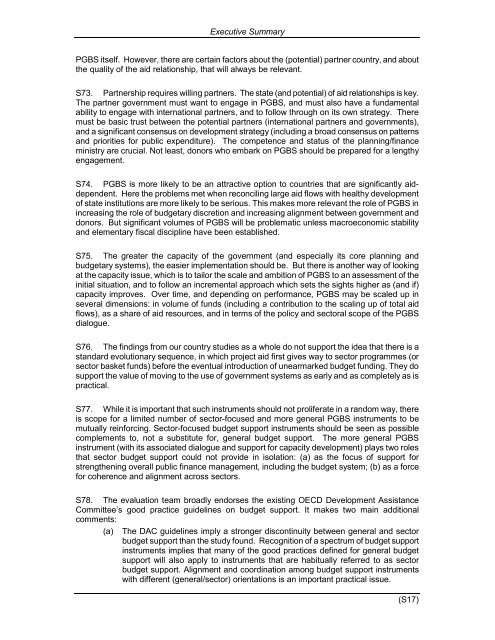Evaluation of General Budget Support: Synthesis Report - Belgium
Evaluation of General Budget Support: Synthesis Report - Belgium
Evaluation of General Budget Support: Synthesis Report - Belgium
You also want an ePaper? Increase the reach of your titles
YUMPU automatically turns print PDFs into web optimized ePapers that Google loves.
Executive Summary<br />
PGBS itself. However, there are certain factors about the (potential) partner country, and about<br />
the quality <strong>of</strong> the aid relationship, that will always be relevant.<br />
S73. Partnership requires willing partners. The state (and potential) <strong>of</strong> aid relationships is key.<br />
The partner government must want to engage in PGBS, and must also have a fundamental<br />
ability to engage with international partners, and to follow through on its own strategy. There<br />
must be basic trust between the potential partners (international partners and governments),<br />
and a significant consensus on development strategy (including a broad consensus on patterns<br />
and priorities for public expenditure). The competence and status <strong>of</strong> the planning/finance<br />
ministry are crucial. Not least, donors who embark on PGBS should be prepared for a lengthy<br />
engagement.<br />
S74. PGBS is more likely to be an attractive option to countries that are significantly aiddependent.<br />
Here the problems met when reconciling large aid flows with healthy development<br />
<strong>of</strong> state institutions are more likely to be serious. This makes more relevant the role <strong>of</strong> PGBS in<br />
increasing the role <strong>of</strong> budgetary discretion and increasing alignment between government and<br />
donors. But significant volumes <strong>of</strong> PGBS will be problematic unless macroeconomic stability<br />
and elementary fiscal discipline have been established.<br />
S75. The greater the capacity <strong>of</strong> the government (and especially its core planning and<br />
budgetary systems), the easier implementation should be. But there is another way <strong>of</strong> looking<br />
at the capacity issue, which is to tailor the scale and ambition <strong>of</strong> PGBS to an assessment <strong>of</strong> the<br />
initial situation, and to follow an incremental approach which sets the sights higher as (and if)<br />
capacity improves. Over time, and depending on performance, PGBS may be scaled up in<br />
several dimensions: in volume <strong>of</strong> funds (including a contribution to the scaling up <strong>of</strong> total aid<br />
flows), as a share <strong>of</strong> aid resources, and in terms <strong>of</strong> the policy and sectoral scope <strong>of</strong> the PGBS<br />
dialogue.<br />
S76. The findings from our country studies as a whole do not support the idea that there is a<br />
standard evolutionary sequence, in which project aid first gives way to sector programmes (or<br />
sector basket funds) before the eventual introduction <strong>of</strong> unearmarked budget funding. They do<br />
support the value <strong>of</strong> moving to the use <strong>of</strong> government systems as early and as completely as is<br />
practical.<br />
S77. While it is important that such instruments should not proliferate in a random way, there<br />
is scope for a limited number <strong>of</strong> sector-focused and more general PGBS instruments to be<br />
mutually reinforcing. Sector-focused budget support instruments should be seen as possible<br />
complements to, not a substitute for, general budget support. The more general PGBS<br />
instrument (with its associated dialogue and support for capacity development) plays two roles<br />
that sector budget support could not provide in isolation: (a) as the focus <strong>of</strong> support for<br />
strengthening overall public finance management, including the budget system; (b) as a force<br />
for coherence and alignment across sectors.<br />
S78. The evaluation team broadly endorses the existing OECD Development Assistance<br />
Committee’s good practice guidelines on budget support. It makes two main additional<br />
comments:<br />
(a) The DAC guidelines imply a stronger discontinuity between general and sector<br />
budget support than the study found. Recognition <strong>of</strong> a spectrum <strong>of</strong> budget support<br />
instruments implies that many <strong>of</strong> the good practices defined for general budget<br />
support will also apply to instruments that are habitually referred to as sector<br />
budget support. Alignment and coordination among budget support instruments<br />
with different (general/sector) orientations is an important practical issue.<br />
(S17)

















